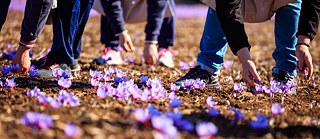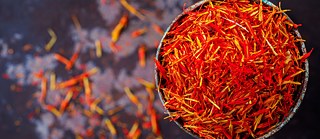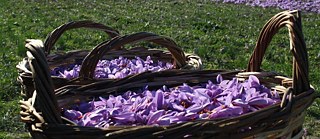Saffron
Magical ingredient

One of the most valuable spices in the world: saffron is popular in Europe and an ingredient of many traditional dishes. The plant gives its colour and aroma to the Spanish paella, the French fish soup bouillabaisse and Greek pastries; its history in Europe goes back thousands of years.
By Yiouli Eptakoili
The two teenagers were practicing discus throwing. An awkward throw of Hermes’ hit Krokos on the head, wounding the loyal friend fatally. Shaken by this loss, the winged god decided to give Krokos immortality. He transformed the soulless body into a beautiful, purple plant, and the three drops of blood that ran from the wound into three red cicatrices in its calyx. Thus, according to this enchanting and melancholy ancient Greek myth, the saffron crocus came to be: one of the most prized species of the Greek plant world.
The origin of saffron is still obscure. In European, North African and Asian countries, the plant has been used for thousands of years as a remedy, spice or dyestuff. Historians have found particularly detailed descriptions of saffron in the lore of ancient Greece and the Roman Empire.
A picture of rare beauty
In Greece and Asia Minor, saffron has been grown for thousands of years and is known as Crocus sativus. Its miraculous and versatile effect is mentioned in Homer (8 BC), the Greek philosopher Theophrastus (371-287 BC), the physician Pedanios Dioscorides (10-90 AD), and in many other written testimonies.Representations of the plant are often found on Minoan frescoes and vase paintings. Famous is the Saffron-Collecting Monkey, the only wall painting of the Middle Minoan period (1600 BC) in Knossos. It shows a monkey collecting saffron in a rocky landscape.

As also in the Saffron Collectors on the Greek island of Santorini: in a mountainous landscape, a woman initiates a young girl into the art of culling the pistil of the flower. She imitates the movements of her teacher, asking for her approval. This image of rare beauty was found on a mural in Akrotiri, Santorini, and dates from the middle of the second millennium BC.
Via the Iberian Peninsula to Europe
The Arabs made a significant contribution to the spread of saffron. They systematically cultivated the plant and in the tenth century introduced it to the Spaniards. Via the Iberian peninsula it then found its way to Europe. It was first cultivated in Greece in the seventeenth century. Cosmopolitan traders in Kozani recognized the value of saffron on European markets and scented opportunities for trading. They imported saffron from Austria and began to grow it in the area around Kozani.Today saffron from Kozani is considered especially choice. It is grown organically and is a protected designation of origin. The flower harvest, the separation by hand of the cicatrices and pistils from the petals, the natural drying and the climate of the area give to saffron from this region the highest quality.
Its impressive reddish-yellow colour and intense aroma are used in many famous recipes, such as bouillabaisse de Marseille from France, Italian risotto à la Milanese, Spanish paella, Moroccan couscous and the fragrant ring-shaped pastries of Astypalea.
“Red gold”
Saffron cultivation is not difficult, but the harvest is exhausting and tedious. It starts in October when the saffron fields around Kozani resemble a purple sea of flowers. The flowers have opened completely. The farmers then start to work in a race against time, because if the flowers are not culled fast enough, their fibres wither.
Kozani saffron is one of the most expensive spices in the world. To produce one kilo of dried saffron threads, you need about 150,000 plants. That is why saffron is rightly called "red gold". Another miracle of the Greek earth.



